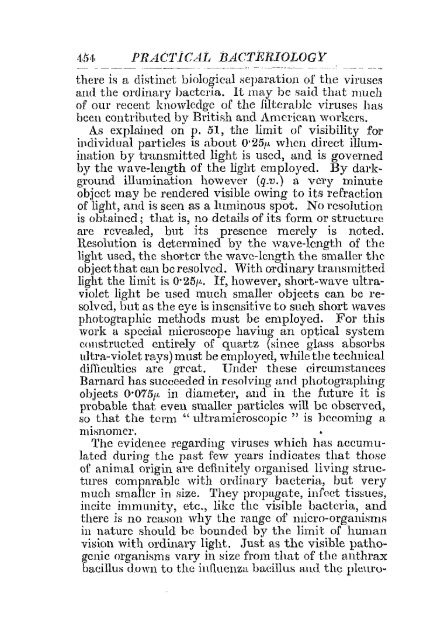AGf~ICULTURAL RESEARCH, PUSA.
AGf~ICULTURAL RESEARCH, PUSA.
AGf~ICULTURAL RESEARCH, PUSA.
You also want an ePaper? Increase the reach of your titles
YUMPU automatically turns print PDFs into web optimized ePapers that Google loves.
4,/)4, PRACl'.lCAL BACTERIOLOGY<br />
thcre is a distinct biological separation of the viruses<br />
and the ordinary bacteria. It may be said that much<br />
of our recent knowledge of the filterable viruses has<br />
been contributed by British and American workers.<br />
As explained on p. 51, the limit of visibility for<br />
il1dividual partides is about 0'25/" when direct illumination<br />
by transmitted light is uscd, and is governed<br />
by the wave-length of the light employed. By darkground<br />
illumination howevel' (q.v.) a VCl'Y minute<br />
object may be rendered visible owing to its refraction<br />
of light, and is seen as a luminous spot. No resolution<br />
is obtained; that is, no details of its form or structUl'C<br />
are revealed, but its presence merely is noted.<br />
Resolution is determined by thc \vave-length of the<br />
light used, the shorter the wave-length the smaller the<br />
object that can be resolved. With ordinary transmitted<br />
light the limit is 0'25/1.. If, however, short-wave ultraviolet<br />
light be used much smaller objects can be resolved,<br />
but as the eye is insensitive to such short waves<br />
photographic methods must be employed. For this<br />
work a special microscope having an optical system<br />
eOllstructed entirely of quartz (since glass absorbs<br />
ultra-violet rays) must be employed, while the technical<br />
diITicultics are great. Under these circumstances<br />
Barnard has succeeded in resolving nnd photographing<br />
objects O'075/L in diameter, and in the future it is<br />
probable that even smaller particles will be observed,<br />
so that the term "ultramicroscopic " is bccoming H<br />
misnomer.<br />
The evidence regarding viruses which has accumulated<br />
during the past few years indicates that those<br />
of animal origin are definitely organised living struchues<br />
comparable with ordinary bacteria, but very<br />
much smaller in size. They propngate, infect tissues,<br />
incite immunity, etc., like the visible bacteria, and<br />
there is no rcason why the range of micro-organisms<br />
in nature should be bounded by the limit of human<br />
vision with ordinary light .• lust as the visible pathogenic<br />
organisms vary in size from that of the anthrax<br />
bacillus down to the influenza baeillus and the pleuru-

















